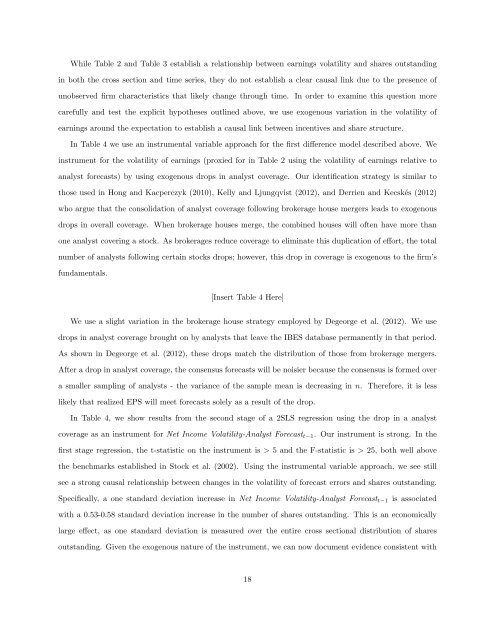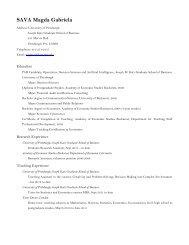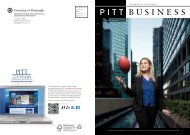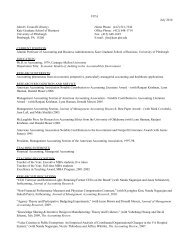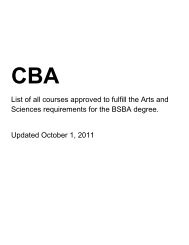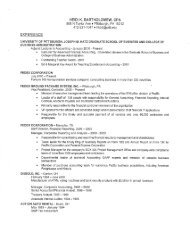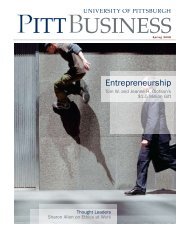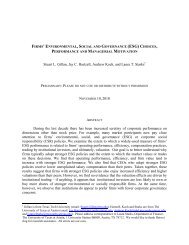Gaming the Float: How Managers Respond to EPS-based Incentives
Gaming the Float: How Managers Respond to EPS-based Incentives
Gaming the Float: How Managers Respond to EPS-based Incentives
Create successful ePaper yourself
Turn your PDF publications into a flip-book with our unique Google optimized e-Paper software.
While Table 2 and Table 3 establish a relationship between earnings volatility and shares outstanding<br />
in both <strong>the</strong> cross section and time series, <strong>the</strong>y do not establish a clear causal link due <strong>to</strong> <strong>the</strong> presence of<br />
unobserved firm characteristics that likely change through time. In order <strong>to</strong> examine this question more<br />
carefully and test <strong>the</strong> explicit hypo<strong>the</strong>ses outlined above, we use exogenous variation in <strong>the</strong> volatility of<br />
earnings around <strong>the</strong> expectation <strong>to</strong> establish a causal link between incentives and share structure.<br />
In Table 4 we use an instrumental variable approach for <strong>the</strong> first difference model described above. We<br />
instrument for <strong>the</strong> volatility of earnings (proxied for in Table 2 using <strong>the</strong> volatility of earnings relative <strong>to</strong><br />
analyst forecasts) by using exogenous drops in analyst coverage. Our identification strategy is similar <strong>to</strong><br />
those used in Hong and Kacperczyk (2010), Kelly and Ljungqvist (2012), and Derrien and Kecskés (2012)<br />
who argue that <strong>the</strong> consolidation of analyst coverage following brokerage house mergers leads <strong>to</strong> exogenous<br />
drops in overall coverage. When brokerage houses merge, <strong>the</strong> combined houses will often have more than<br />
one analyst covering a s<strong>to</strong>ck. As brokerages reduce coverage <strong>to</strong> eliminate this duplication of effort, <strong>the</strong> <strong>to</strong>tal<br />
number of analysts following certain s<strong>to</strong>cks drops; however, this drop in coverage is exogenous <strong>to</strong> <strong>the</strong> firm’s<br />
fundamentals.<br />
[Insert Table 4 Here]<br />
We use a slight variation in <strong>the</strong> brokerage house strategy employed by Degeorge et al. (2012). We use<br />
drops in analyst coverage brought on by analysts that leave <strong>the</strong> IBES database permanently in that period.<br />
As shown in Degeorge et al. (2012), <strong>the</strong>se drops match <strong>the</strong> distribution of those from brokerage mergers.<br />
After a drop in analyst coverage, <strong>the</strong> consensus forecasts will be noisier because <strong>the</strong> consensus is formed over<br />
a smaller sampling of analysts - <strong>the</strong> variance of <strong>the</strong> sample mean is decreasing in n. Therefore, it is less<br />
likely that realized <strong>EPS</strong> will meet forecasts solely as a result of <strong>the</strong> drop.<br />
In Table 4, we show results from <strong>the</strong> second stage of a 2SLS regression using <strong>the</strong> drop in a analyst<br />
coverage as an instrument for Net Income Volatility-Analyst Forecast t−1 . Our instrument is strong. In <strong>the</strong><br />
first stage regression, <strong>the</strong> t-statistic on <strong>the</strong> instrument is > 5 and <strong>the</strong> F-statistic is > 25, both well above<br />
<strong>the</strong> benchmarks established in S<strong>to</strong>ck et al. (2002). Using <strong>the</strong> instrumental variable approach, we see still<br />
see a strong causal relationship between changes in <strong>the</strong> volatility of forecast errors and shares outstanding.<br />
Specifically, a one standard deviation increase in Net Income Volatility-Analyst Forecast t−1 is associated<br />
with a 0.53-0.58 standard deviation increase in <strong>the</strong> number of shares outstanding. This is an economically<br />
large effect, as one standard deviation is measured over <strong>the</strong> entire cross sectional distribution of shares<br />
outstanding. Given <strong>the</strong> exogenous nature of <strong>the</strong> instrument, we can now document evidence consistent with<br />
18


